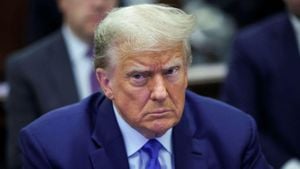The U.S. dollar experienced a surprising decline recently as traders reacted to shifting political fortunes surrounding Vice President Kamala Harris. Just as speculation about the potential Democratic presidential candidate heated up following President Joe Biden's early decision to step aside, Harris's leading position in various polls marked the start of new dynamics within the market.
On Monday, during the first trading session of the week, the U.S. Dollar Index (DXY), which gauges the dollar's performance against six major currencies, fell to its lowest point in nine days. This downturn marked a staggering reversal from the dollar's previous gains, which had largely stemmed from predictions favoring former President Donald Trump over Harris.
Traders were swiftly pulling their investments from what they called the "Trump trades," investments predicated on the belief Trump was positioned to defeat Harris. Yet, as recent polls indicated Harris's growing momentum, investors reassessed their risk across the board, especially concerning the currencies linked to the U.S. economy.
This market reaction isn't entirely surprising. Harris, who could become the first Black woman to hold such high status within the Democratic Party, has demonstrated significant influence and support among voters. Increasing confidence from investors seemed tied not only to her popular favor but to her political actions since losing to Trump last month. Harris's swift acknowledgment of the election's outcome symbolized her commitment to fostering trust and stability within the framework of American democracy. "We must accept the results of this election," she asserted, reinforcing the importance of transitioning power smoothly.
Meanwhile, amid these political ripples, Harris's trip to San Francisco signaled engagements and reflections on her political future. Back from vacationing in Hawaii, Harris traversed her hometown, fueling fresh conjectures on what her next steps might be. Even though the ink was still drying from her concession speech to Trump, whispers of 2028 ambitions or even attempts at the California governorship soon surfaced.
Political analysts, such as Larry Gerston, suggested Harris now faces pivotal decisions. “Which path do I want? A path where I’m likely to succeed, which may lead toward the governorship, or one leading to the top office—but is less certain,” he pondered.
Harris's historical relevance cannot be overstated either; her ascent offers not only personal milestones but significant representation for many across the U.S., reflecting diverse aspirations. Onlookers now speculate whether she could be eyeing potential runs at state political power versus another at the national level, both avenues offering opportunities to carve her future more directly.
The stakes feel heightened, especially with looming presidential primaries and the weighty responsibility of reinvigorated Democratic leadership. If her popularity continues to rise, Harris might effectively channel the support she garnered throughout her vice presidency, aiming to unite factions within the party as it readies for the next national stage.
Such political chess matches invariably affect market behaviors and economic forecasts, where performance indicators like consumer confidence, spending patterns, and broader financial strategies intertwine closely with electoral outcomes. The drop of the dollar, linked to these anticipated shifts, showcases just how closely tied economic parameters remain to political narratives.
Traders and financial experts remained cautious as Harris’s path crystallized; some view her as a unifying candidate who could bridge divides and resonate across varied demographics. Through her presidency, if achieved, expectations could shift dramatically impacting not only the U.S. political framework but also its economic standing globally.
The environment suggests market movements will likely continue to respond to electoral developments closely, with every rise or fall rooted firmly within the political sphere. Harris’s political machinations appear poised to hold substantial sway—not just through voter sentiments but also influencing traders’ portfolios and economic forecasts.
What will happen next remains uncertain, but for now, as Harris continuously defies historical odds, so too the market dances to the rhythm of her aspirations, poised to pivot on ensuing developments.
Those inside the financial sector appear to understand this ebb and flow—infusing confidence where once volatility prevailed. Harris’s advancing prospects could very well be the catalyst traders need to rethink their longitudinal strategies, recognizing the intertwined narrative of politics and currency.



